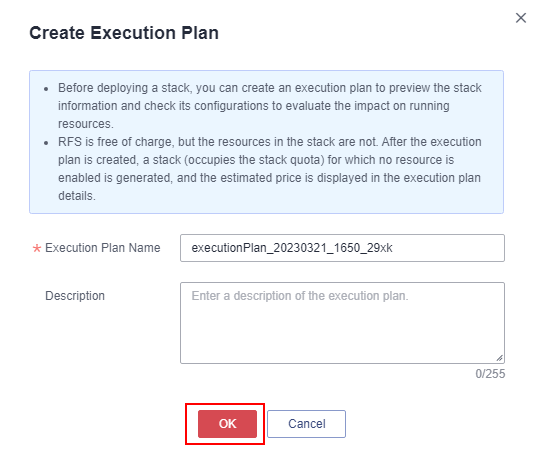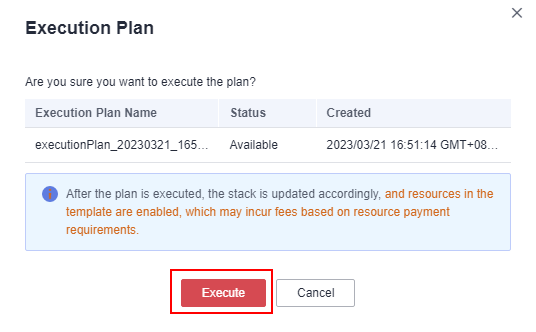Quick Deployment
This section describes how to deploy the solution.
|
Parameter |
Type |
Mandatory |
Description |
Default Value |
|---|---|---|---|---|
|
vpc_name |
String |
Yes |
The prefix of a Virtual Private Cloud (VPC) name. The VPC naming format is {vpc_name}_vpc. This template uses a newly created VPC and the VPC name must be unique. The prefix can contain 1 to 57 characters and can include letters, digits, underscores (_), hyphens (-), and periods (.). |
highly-available-rabbitmq-cluster_demo |
|
secgroup_name |
String |
Yes |
The prefix of a security group name. The security group naming format is {secgroup_name}_secgroup. This template uses a newly created security group. For details about how to configure security group rules, see the (Optional) Modifying Security Group Rules. It can contain 1 to 55 characters and can include letters, digits, underscores (_), hyphens (-), and periods (.). |
highly-available-rabbitmq-cluster_demo |
|
ecs_name |
String |
Yes |
ECS name, which must be unique. The ECSs are named {ecs_name}-node01, {ecs_name}-node02, and {ecs_name}-node03. It can contain 1 to 57 characters and can include letters, digits, and hyphens (-). |
highly-available-rabbitmq-cluster-demo |
|
ecs_flavor |
String |
Yes |
ECS flavor. For more flavors, see A Summary List of x86 ECS Specifications. |
s6.medium.2 |
|
ecs_password |
String |
Yes |
ECS initial password. After an ECS is created, log in to the ECS console and change the password by referring to Resetting the Password for Logging In to an ECS on the Management Console. It can contain 8 to 26 characters and must include at least three of the following character types: uppercase letters, lowercase letters, digits, and special characters (!@$%^-_=+[{}]:,./?). The administrator is root. |
Left blank |
|
system_disk_size |
String |
Yes |
System disk size, in GiB. The value ranges from 1 to 1024. The system disk size cannot be scaled down. |
40 |
|
data_disk_size |
String |
Yes |
Data disk size, in GiB. The value ranges from 10 to 32768. |
100 |
|
charging_mode |
String |
Yes |
Billing mode. By default, fees are automatically deducted. The value can be prePaid (yearly/monthly) or postPaid (pay-per-use). |
prePaid |
|
charging_unit |
String |
Yes |
The value can be year or month. This parameter is mandatory when charging_mode is set to prePaid. |
month |
|
charging_period |
number |
Yes |
When charging_unit is set to year, the value ranges from 1 to 3. When charging_unit is set to month, the value ranges from 1 to 9. This parameter is mandatory when charging_mode is set to prePaid. |
1 |
|
eip_bandwidth_size |
number |
Yes |
EIP bandwidth size. This template uses an EIP billed by bandwidth. The value ranges from 1 Mbit/s to 2000 Mbit/s. |
5 |
|
RabbitMQ_username |
String |
Yes |
RabbitMQ username. It can contain 5 to 16 characters and can include letters and digits. |
admin |
|
RabbitMQ_password |
String |
Yes |
Password of the RabbitMQ user. After the creation is complete, change the password by following the instructions provided in the deployment guide. It can contain 6 to 12 characters and can include letters, digits, and special characters (!@$#%^-=+,./?) |
Left blank |
- Log in to Huawei Cloud Solution Best Practices, choose Quickly Deploying a High-Availability RabbitMQ Cluster, and click Deploy.
Figure 1 Selecting a solution

- On the Select Template page, click Next.
Figure 2 Select Template

- On the Configure Parameters page, enter a stack name, configure parameters according to Table 1, and click Next.
Figure 3 Configure Parameters

- On the Configure Stack page, select the rf_admin_trust agency and click Next.
Figure 4 Configure Stack

- On the Confirm Configurations page, click Create Execution Plan.
Figure 5 Confirm Configurations

- In the displayed Create Execution Plan dialog box, enter an execution plan name and click OK.
Figure 6 Create Execution Plan

- Wait until the status of the execution plan changes to Available and click Deploy in the Operation column. In the displayed dialog box, click Execute.
Figure 7 Execution plan created
 Figure 8 Confirming the execution plan
Figure 8 Confirming the execution plan
- Wait until automatic deployment is complete, and click the Events tab to view details.
Figure 9 Resources created
 Figure 10 Execution plan complete
Figure 10 Execution plan complete
- Click the Outputs tab to view information about the VIP and ECSs.
Figure 11 Outputs

Feedback
Was this page helpful?
Provide feedbackThank you very much for your feedback. We will continue working to improve the documentation.See the reply and handling status in My Cloud VOC.
For any further questions, feel free to contact us through the chatbot.
Chatbot





